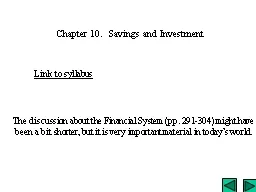

Link to syllabus The discussion about the Financial System pp 291304 might have been a bit shorter but it is very important material in todays world SavingsInvestment Identity p 277 ID: 357642
Download Presentation The PPT/PDF document "Chapter 10. Savings and Investment" is the property of its rightful owner. Permission is granted to download and print the materials on this web site for personal, non-commercial use only, and to display it on your personal computer provided you do not modify the materials and that you retain all copyright notices contained in the materials. By downloading content from our website, you accept the terms of this agreement.
Slide1
Chapter 10. Savings and Investment
Link to syllabus
The discussion about the Financial System (pp.
291-304)
might have
been a bit shorter, but it is very important material in today’s
world
.Slide2
Savings-Investment Identity (p. 277)
Ignore government and foreign trade: Income = Consumption + Savings
Expenditures = Consumption + Investment So, Savings=investmentKey Keynesian insight: savers and investors are different economic
people, and are affected by different economic factors. e.g. Consumption/saving affected by income, future plans, interest rates. Business investment affected by profitability.
With gov’t and trade,
Investment =
Savings
personal
+ (
Taxes-Gov. Spend
) + capital inflows.Slide3
Savings-Investment Identity: US and Japan Fig.10-1, p.279
Shows how capital inflows (or outflows) combine with private
savings to finance domestic investment.Year is 2007 – pre-crisis.Slide4
Global Data: Savings Rates, 2007. p. 280
U.S. has relatively low savings rates.Slide5
The Demand for Loanable Funds. Fig 10-2, p. 281
Depends on: Opportunities for business investments
Financing of government deficitsSlide6
The Supply of Loanable Funds. Fig 10-3 p. 283
Depends on: Individuals’ savings habits
International loansSlide7
Equilibrium in the Loanable Funds Market. Fig 10-4 p. 284Slide8
An Increase in the Demand for Loanable Funds. Fig. 10-5 p. 286.
Standard example; increased government deficit, financed internallySlide9
An Increase in the Supply of Loanable Funds. Fig 10-6 p. 287
Example: people decide to save more, consume less.Slide10
The Fisher Effect. Figure 10-7 p. 289.
(How a change in expected inflation increases the nominal interest
rate).Slide11
Irving Fisher. 1867-1947
Irving Fisher was one of the earliest American neo-classical c economists, of unusual mathematical
sophistication. ( 1) his contributions to the
Walrasian
theory of equilibrium
price
(he also invented the indifference curve device)
in
1892; 2) His volumes on the theory of capital and
I
investment
(1896, 1898, 1906, 1907, 1930) which
brought
the Austrian
intertemporal
theories into the
English-
speakin
speaking
world
, wherein
he introduced the famous distinction between "stocks" and flows", the Fisher Separation Theorem and the
loanable funds theory of interest rates
. 3) his famous resurrection of the
quantity theory of money
(1911, 1932, 1935); (4) the theory of index numbers (1922);
This Yale economist was an eccentric and colorful figure. When Irving Fisher wrote his 1892 dissertation, he constructed a remarkable machine equipped with pumps, wheels, levers and pipes in order to illustrate his price theory. Socially, he was an avid advocate of eugenics and health food diets. He made a fortune with his visible index card system - known today as the rolodex - and advocated the establishment of an 100% reserve requirement banking system His fortune was lost and his reputation was severely marred by the 1929 Wall Street Crash, when just days before the crash, he was reassuring investors that stock prices were not overinflated but, rather, had achieved a new, permanent plateau.Slide12
Changes in US Interest Rates, Figure 10-8 p. 290
Illustrates that sometimes interest rates are increased by expected
inflation, and other times other factors dominate.Slide13
The US Housing Bubble. Fig 10-9 p. 303